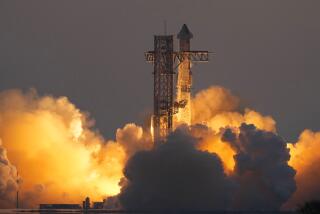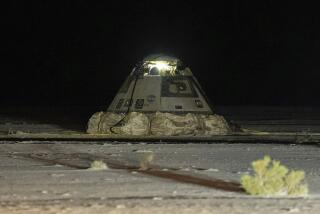Eastern Storms Force Shuttle to Land at Edwards
- Share via
EDWARDS AIR FORCE BASE — Diverted across the continent because of Florida thunderstorms, space shuttle Discovery touched down safely at its alternative landing site here Tuesday afternoon beneath clear blue skies.
The landing ended an 11-day voyage highlighted by the first untethered space walk by U.S. astronauts in a decade.
NASA officials said that no significant technical problems marred the flight or the landing of the space vessel that carried five men and one woman.
“Discovery turned in an almost flawless performance,” said Loren Shriver, NASA launch integration manager during a post-mission briefing in Houston that was seen by closed-circuit television at Edwards.
The shuttle stayed aloft two days longer than planned because of stormy weather near the orbiter’s primary landing site at Cape Canaveral. Shriver said NASA opted to keep the shuttle in space past its scheduled landing in hopes that the Florida weather would clear.
The Edwards landing boosted the cost of this mission by about $1 million, NASA officials said, because of additional personnel expenses and the cost of ferrying the spacecraft back to its Florida launching site atop a modified Boeing 747 jet.
A California landing also means the spacecraft won’t get back to its home base for at least five or six days.
After two opportunities for a Florida landing went by Tuesday morning, Shriver said, NASA officials decided it “just wasn’t in the cards this time,” and they opted for California.
By about 2 p.m., about 1,000 NASA workers and 500 visitors were gathered on the ground and on rooftops at the base to listen for the descending shuttle’s distinctive double sonic booms (which were clearly heard in the San Fernando Valley) and to scan the skies for a glimpse of the craft.
As Discovery touched down at 2:14 p.m., a recording of the “Star Spangled Banner” burst out of loudspeakers at the NASA complex.
The Discovery astronauts were whisked inside to undergo medical tests. They are scheduled to fly back to Houston early today.
The untethered space walk on Friday, 150 miles above Earth, was to test a new type of personal jet pack. The device, tested in turns by astronauts Mark Lee and Carl Meade, was designed to propel the wearer through space during an emergency. Crews working outside future space stations might be equipped with them.
Another scientific highlight of the mission was the firing of laser pulses toward Earth. NASA officials said data gathered from this test will lead to a better understanding of Earth’s climate and help scientists learn how human activity is affecting the atmosphere.
During the mission, the astronauts also turned loose a $14-million satellite that studied the sun’s corona for two days. Then the crew retrieved the satellite so that it could be returned to Earth.
The mission was Discovery’s 19th trip into space and NASA’s 64th shuttle mission, including the tragic Challenger launch in 1986.
More to Read
Sign up for Essential California
The most important California stories and recommendations in your inbox every morning.
You may occasionally receive promotional content from the Los Angeles Times.










